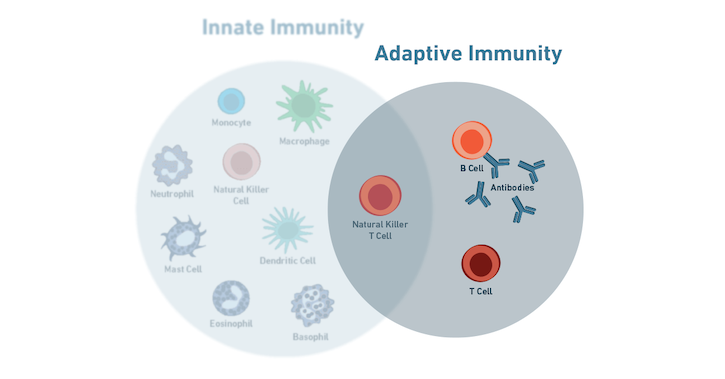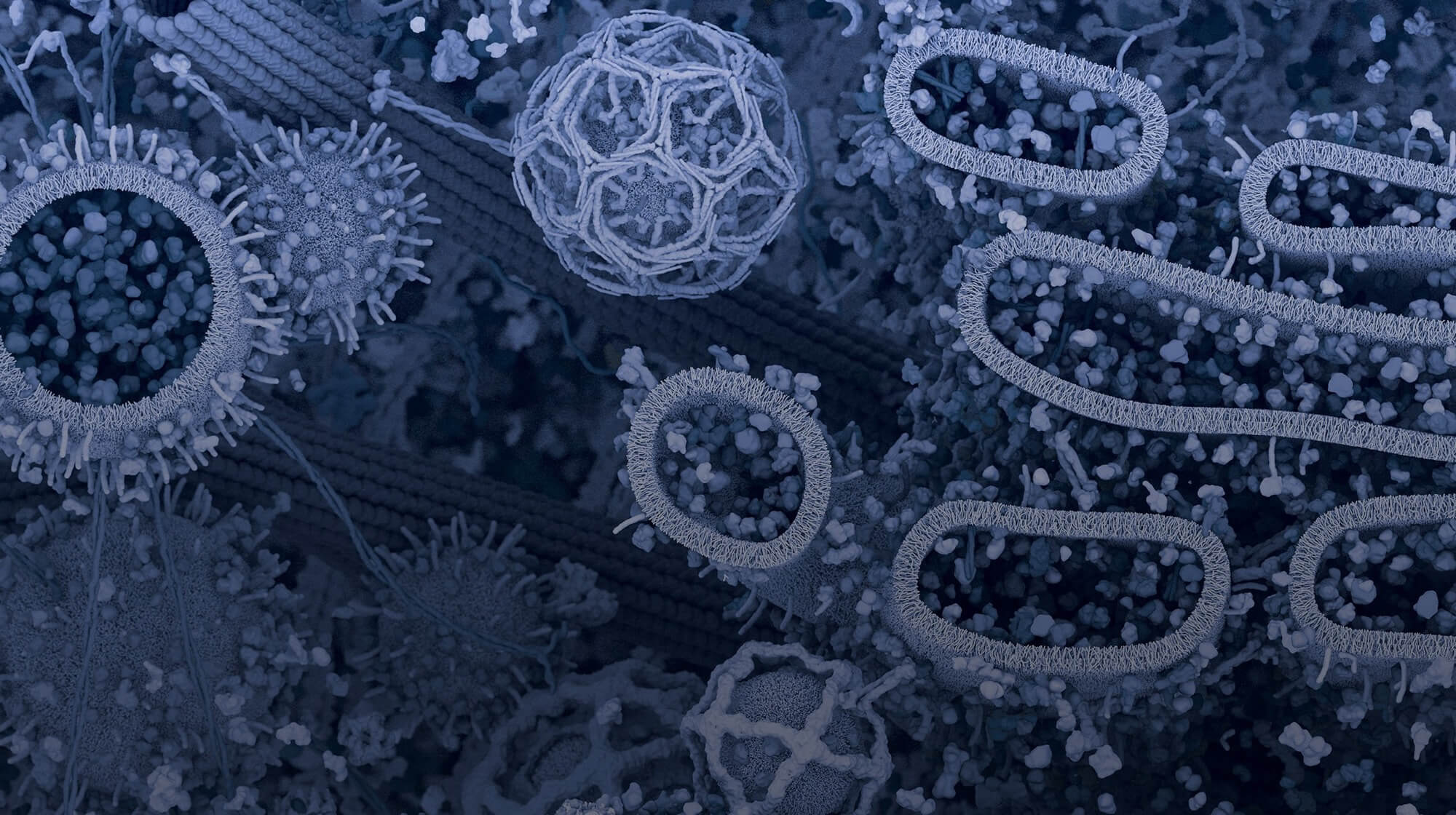Have you ever wondered how people are able to develop immunity to specific diseases? This important question has been the focus of many critical medical and immunological research endeavors. The answer is that it’s all due to the cells and antibodies of the adaptive immune system.
The Adaptive Immune System
The adaptive immune response is extremely advantageous because it targets very specific pathogens and can store a “memory” of that pathogen for many years, so a faster response can be mounted with subsequent encounters. This immunological memory is the principle behind vaccines. They prime our immune system using an encounter with an inactivated virus, which allows us to fight off that disease quicker and easier in the future. While the innate immune system is very quick to respond, the adaptive immune system takes longer to mount this specialized attack, i.e. several days or weeks.

As mentioned in the previous blog post in this series, there are many different types of cells and factors that take action once an invading pathogen has been detected in the body. It is important to note that the adaptive immune response can only be mobilized when specifically triggered by cells from the innate immune system. This usually occurs when the innate immune response is not sufficient to fight off an infection. Thus, the innate and adaptive immune responses work in concert with each other to provide lasting immunity.
Overall, one of the most critical jobs of the immune system is to distinguish self from non-self. Any macromolecule that is detected as non-self is called an antigen. Not all antigens are harmful, such as those from food particles, pollen, dander, or dust. And there are many macromolecules that are considered self, including identifying molecules on the body’s cells and beneficial bacteria. Importantly, when the body has trouble distinguishing self from non-self, chronic health conditions can present themselves and they range from allergies to autoimmune disorders, such as systemic lupus erythematosus and Multiple sclerosis.
Once an innate immune cell, such as a macrophage or other antigen-presenting cell (APC) engulfs an invading bacteria, virus, or vaccine, they often travel to a lymph node and present an antigen from that pathogen on the cell surface to T cells. They present the new antigen using specific receptors on their cell surface called major histocompatibility complexes, or MHCs; typically type II. T cells detect this unique antigen/receptor presentation via specific receptors called T Cell Receptors (TCRs).
There are several types of T cells that can be activated at different times after an infection, each with a different specialized job. Two major types of T cells are helper T (Th) cells and cytotoxic T cells. Th cells act as crucial mediators to activate other cells, including cytotoxic T cells and B cells. Cytotoxic T cells are specialized killers that attack virally infected cells or even cancerous cells. Some, such as the Natural Killer T cells, are able to identify and kill cancerous cells without the need to detect MHC receptors. Once they target one of these cells, Cytotoxic T cells use perforins, granzymes, and proteases, or even FAS ligand signaling to trigger the caspase cascade and induce apoptosis in the unhealthy cell. Both helper T cells and cytotoxic T cells release cytokines when activated. These extracellular cytokine signals can recruit and cue the proliferation of other lymphocytes to bolster the immune response.
Cytokines can help induce the maturation of immature T and B cells. Naïve B cells in the spleen or lymph nodes can be activated in a few different ways, but typically need a more than one step to differentiate into plasma cells that secrete antibodies against a specific antigen and therefore, pathogen. Naïve B cells require the binding of a specific antigen to their B Cell Receptors (BCRs), so that they can present the antigen via MHC class II receptors on their cell surface to helper T cells. Helper T cells then release cytokines and that leads to the proliferation and differentiation of the B cells into plasma cells. These plasma cells then secrete antibodies into the lymph and blood to target the specific pathogen. It is important to note that BCRs on the surface of B cells are almost structurally identical to the antibodies that are ultimately released.
Antibodies, or immunoglobulins, are large Y-shaped glycoproteins that specifically target an invading pathogen and excel at neutralizing bacteria and viruses present in the body’s fluids or extracellular space. They can do this by binding to the surface receptors on the pathogen that may be necessary for it to invade cells. They can also trigger agglutination and the precipitation of clumps of the pathogen to make it easier for macrophages to engulf them. Ultimately, they may also activate the Complement System, described in our previous blog in this series, which can lead to the lysis of harmful bacteria.
Once the peak of an infection and immune response has passed, some of the remaining T and B cells, which have been trained to recognize a specific antigen, are saved as memory T and B cells. These memory cells are primed to proliferate and become active once again if there is a subsequent encounter with that specific pathogen. This allows the immune system to respond quicker and with more force than with the first encounter.
Regulatory T cells (Tregs) are also a key part of the adaptive immune system that act as a critical off switch. They keep the immune response in check by suppressing the activity of T Cells to ensure that the immune system doesn’t overreact and attack self-antigens or other non-threatening signals. Dysfunction with these types of cells can lead to autoimmune disease. Research has indicated that modulating the function of Tregs could be very useful for the treatment of autoimmune diseases, cancer, and organ transplant recipients.
The complex nature of the development of T and B cells leads to the distinguishing receptors they display on their cell surface and the interactions that they have with each other activates multiple signaling cascades in each cell. In the next blogs in this series we will dive more into these details and learn about the ways researchers can detect and identify specific immune cells.
Additional Resources:
Read the three-part immunology blog series:
- Immunology Overview: How Does Our Immune System Protect Us?
- Immunology: How Does the Innate Immune System Work?
Select References:
- https://opentextbc.ca/biology/chapter/23-2-adaptive-immune-response/
- https://courses.lumenlearning.com/boundless-ap/chapter/adaptive-immunity/
- Innate and Adaptive Immune Memory: an Evolutionary Continuum in the Host’s Response to Pathogens
- Mihai G. Netea, Andreas Schlitzer, Katarzyna Placek, Leo A.B. Joosten, and Joachim L. Schultze
- Immunity: The Immune Response in Infectious and Inflammatory Disease, By Anthony L. DeFranco, Richard M. Locksley, Miranda Robertson
- Immunobiology: The Immune System in Health and Disease. 5th edition. Janeway CA Jr, Travers P, Walport M, et al. New York: Garland Science; 2001.




